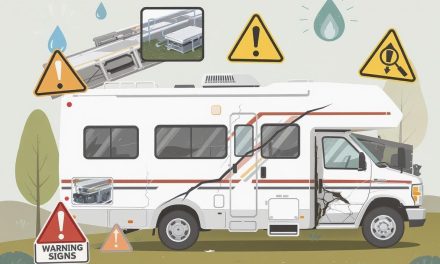Would you like to save this article?
Transform your tired RV interior without breaking the bank – here’s everything you need to know about breathing new life into your motorhome furniture
Are you staring at peeling, cracked, or faded RV furniture wondering if it’s time to throw in the towel? You’re not alone! Thousands of RV owners face this exact dilemma every year.
The good news? Yes, RV furniture can absolutely be reupholstered – and it might just be the smartest money decision you’ll make for your home on wheels.
But before you dive in headfirst, there are some crucial things you need to know. Making the wrong choice could cost you hundreds or even thousands of dollars.
This guide will walk you through everything – from costs to complications to amazing success stories that will inspire your next project.
1. The Simple Answer: Yes, But It’s More Complex Than You Think
RV furniture can definitely be reupholstered, but it’s not always the simple DIY project you might imagine. Unlike your home furniture, RV pieces face unique challenges:
- Space constraints make working difficult
- Weight restrictions mean every ounce matters
- Road vibrations demand stronger construction
- Multiple frame types require different approaches
The key is understanding what you’re working with before you start. Many RV owners jump in without proper planning and end up spending more than if they’d bought new furniture!
Why RV Furniture is Different
RV manufacturers use specific materials and construction methods to handle the constant movement and space limitations. Your dining room table might be wood-framed, but your RV dinette could be metal-framed with completely different upholstery attachment methods.
2. Wood Frame vs Metal Frame: The Game-Changing Difference
This is where many DIY projects go wrong. The type of frame in your RV furniture determines the entire reupholstering process – and the difficulty level.
Wood-Framed Furniture (The Easy Option)
- How it works: Fabric is stapled directly to the wooden frame, piece by piece
- DIY difficulty: Beginner-friendly
- Tools needed: Staple gun, heavy-duty staples, basic hand tools
- Best for: Older RVs, custom-built pieces, solid wood construction
Metal-Framed Furniture (The Professional Challenge)
- How it works: Complete covers are sewn like fitted sheets, then stretched over the frame and secured with hog rings
- DIY difficulty: Advanced to expert level
- Tools needed: Industrial sewing machine, hog ring pliers, specialized templates
- Best for: Most modern RVs, Flexsteel furniture, recliners
Quick Frame Test
Not sure what you have? Look underneath your furniture or remove a cushion. If you see wooden slats or solid wood, you’re in luck! If you see metal tubes or wire frames, consider professional help.
3. The Real Cost Breakdown: Professional vs DIY vs Replacement
Here’s where the rubber meets the road. Understanding the true costs will help you make the smartest financial decision.
Professional Reupholstering Costs (2024)
| Furniture Type | Cost Range | Timeline |
|---|---|---|
| Single Chair | $400 – $800 | 2-4 weeks |
| Love Seat | $800 – $1,200 | 3-5 weeks |
| Full Sofa | $1,000 – $1,800 | 4-6 weeks |
| Dinette Set (4 pieces) | $600 – $1,200 | 3-4 weeks |
| Captain’s Chairs (pair) | $800 – $1,400 | 3-5 weeks |
DIY Reupholstering Costs
| Item | Cost Range | Notes |
|---|---|---|
| Marine Vinyl Fabric | $15 – $35 per yard | Need 3-8 yards depending on piece |
| Tools (first time) | $100 – $300 | Staple gun, heavy-duty staples, scissors |
| Foam Replacement | $50 – $200 | If existing foam is worn |
| UV-Resistant Thread | $10 – $25 | Essential for outdoor durability |
| Total First Project | $200 – $600 | Plus your time and effort |
New RV Furniture Costs
| Furniture Type | Budget Range | Premium Range |
|---|---|---|
| RV Sofa | $800 – $1,500 | $2,000 – $4,000 |
| RV Recliner | $600 – $1,200 | $1,500 – $3,000 |
| Dinette Set | $500 – $1,000 | $1,200 – $2,500 |
| Captain’s Chairs | $400 – $800 each | $1,000 – $2,000 each |
4. When Reupholstering Makes Perfect Sense
Not every situation calls for reupholstering. Here are the golden scenarios where it’s usually the best choice:
✅ Reupholster When:
- High-quality original furniture (you paid $2,000+ originally)
- Solid, sturdy frame with no structural damage
- Perfect fit for your space (custom or hard-to-replace dimensions)
- Sentimental value (family heirloom or beloved piece)
- Wood-framed furniture in good condition
- Budget constraints but need a fresh look
Real Success Story
“We had a $3,500 Flexsteel sofa that started peeling after 8 years. Professional reupholstery cost $1,200 and it looks brand new. Best decision we made!” – Linda K., Full-time RVer
5. When to Walk Away and Buy New Instead
Sometimes reupholstering is throwing good money after bad. Here’s when to cut your losses:
❌ Don’t Reupholster When:
- Structural damage (broken springs, cracked frame, sagging support)
- Low-quality original piece (under $800 new)
- Metal frame requiring professional work that costs 80%+ of replacement
- Mold or deep stains that go beyond surface fabric
- Wrong size for your current needs
- Outdated mechanism (broken recliners, worn hydraulics)
The $800 Rule
Industry experts suggest: If your furniture originally cost under $800, replacement is usually more cost-effective than professional reupholstering.
6. DIY Reupholstering: Step-by-Step Success Guide
Ready to tackle a wood-framed piece yourself? Here’s the process that works:
For beginners, watch this excellent tutorial:
Phase 1: Planning and Preparation
- Document everything – Take photos from multiple angles before disassembly
- Test your frame – Check for solid wood construction and structural integrity
- Choose your fabric – Marine vinyl is most popular for durability
- Gather tools – Heavy-duty staple gun, sharp scissors, seam ripper
Phase 2: Removal and Template Creation
- Carefully remove old fabric – Save pieces as templates
- Clean the frame – Remove old staples and debris
- Inspect foam – Replace if compressed or damaged
- Label everything – Note which piece goes where
For dinette cushions specifically, this tutorial is perfect: – Clear step-by-step process.
Phase 3: Cutting and Installation
- Cut new fabric – Add 2-3 inches extra on all sides
- Start at centers – Begin stapling at the middle of each side
- Work toward corners – Keep fabric taut but not overstretched
- Finish corners neatly – Fold like wrapping a present
Phase 4: Final Assembly
- Trim excess fabric – Leave about 1/2 inch beyond staples
- Reassemble furniture – Follow your photos for correct order
- Add finishing touches – Piping or trim for professional look
For a complete couch makeover, check out: – Comprehensive guide for larger pieces.
7. Fabric Selection: The Make-or-Break Decision
Your fabric choice will determine how long your project lasts and how it handles RV life.
Top Fabric Choices for RVs
Marine Vinyl (Most Popular)
- Pros: Waterproof, UV-resistant, easy cleaning, durability
- Cons: Can be hot in summer, less breathable
- Best for: High-traffic areas, families with kids/pets
- Cost: $15-35 per yard
Solution-Dyed Acrylic
- Pros: Breathable, fade-resistant, comfortable, natural feel
- Cons: More expensive, needs more care
- Best for: Indoor use, adult-only RVs
- Cost: $25-45 per yard
Heavy-Duty Polyester
- Pros: Budget-friendly, good durability, easy to work with
- Cons: Less UV protection, may fade over time
- Best for: Light-use furniture, temporary solutions
- Cost: $10-20 per yard
Fabric Shopping Tips
- Buy 10% extra – Better safe than sorry
- Check UV ratings – Essential for window-adjacent furniture
- Test samples first – Order swatches to see colors in your RV
- Consider maintenance – How easy is it to clean?
8. Professional vs DIY: Making the Smart Choice
The decision between doing it yourself or hiring a pro isn’t always about money.
Choose DIY When:
- Wood-framed furniture with simple shapes
- You enjoy crafting and have time
- Budget is tight but timeline is flexible
- Simple, straight-line pieces like bench cushions
- You want to learn the skill for future projects
For amazing DIY inspiration, watch: – Proof that budget projects can look incredible!
Choose Professional When:
- Metal-framed furniture with complex shapes
- Recliners or mechanisms are involved
- Timeline is critical (you need it done fast)
- High-value pieces where mistakes are costly
- Multiple pieces need coordinated look
To see professional techniques in action: – Shows what professionals can accomplish.
Questions to Ask Professionals:
- Do you specialize in RV furniture?
- Can you work with my existing frame?
- What’s included in the price?
- How long is the warranty?
- Can I see examples of similar work?
9. Common Mistakes That Cost Money and Time
Learn from others’ expensive mistakes:
Costly DIY Mistakes
- Not testing fabric stretch – Some fabrics don’t work for curves
- Skipping the template – Guessing measurements wastes expensive fabric
- Wrong staple size – Too short won’t hold, too long splits wood
- Ignoring grain direction – Makes fabric wear unevenly
- Forgetting UV protection – Fabric fades within months
Professional Hiring Mistakes
- Not checking RV experience – Home furniture pros may struggle
- Assuming all work is included – Frame repair often costs extra
- Not getting timeline in writing – Projects can drag on
- Skipping the warranty discussion – What happens if it fails?
For repair techniques instead of full reupholstery: – Sometimes a simple fix is all you need!
10. Tools, Timeline, and Success Tips
Essential Tools for DIY Success
| Tool | Why You Need It | Expected Cost |
|---|---|---|
| Heavy-duty staple gun | Standard staplers won’t penetrate | $30-80 |
| 3/8″ staples | Right size for most upholstery | $10-20 |
| Sharp fabric scissors | Clean cuts prevent fraying | $15-40 |
| Seam ripper | Remove old fabric without damage | $5-10 |
| Measuring tape | Accurate fabric calculations | $5-15 |
| Hot knife (optional) | Prevents vinyl from fraying | $25-50 |
Realistic Timeline Expectations
- Simple cushion: 2-4 hours
- Basic chair: 4-8 hours
- Sofa or love seat: 8-16 hours
- Complete dinette set: 12-20 hours
Remember: First projects always take longer as you learn!
Success Tips from Experienced RVers
- Start small – Do a throw pillow first to test your skills
- Work in good light – Poor lighting leads to mistakes
- Take breaks – Tired hands make sloppy work
- Keep old fabric – Great for future repairs or patches
- Document your process – Photos help with future projects
For professional-level results at home: – Detailed 4K tutorial from Sailrite.
Alternative no-sew approach: – Perfect for those who don’t want to sew.
For cushion-making from scratch: – Complete cushion construction tutorial.
The Bottom Line: Your Next Steps
Can RV furniture be reupholstered? Absolutely! But success depends on making smart decisions based on your specific situation.
Quick Decision Guide:
- High-value, wood-framed, structurally sound = Reupholster
- Low-value, damaged, or metal-framed = Consider replacement
- Sentimental or perfect-fit pieces = Reupholster with professional help
- Multiple pieces needing coordination = Get professional quotes
Start Your Project Right:
- Assess your furniture honestly – frame type, condition, original value
- Get multiple quotes if considering professional work
- Start with a small piece if going DIY
- Budget for quality materials – cheap fabric means redoing it sooner
- Plan for learning curve – first projects take longer
Remember, a successful reupholstery project can give you furniture that looks better than new, fits perfectly, and costs significantly less than replacement. The key is matching your approach to your situation and skill level.
Sources
- Bradd & Hall – RV Furniture: Is It Better To Buy New Or Reupholster?
- Active RV Upholstery – Why Reupholstering RV Furniture Is Better Than Replacing It
- Marine Vinyl Fabric – How to Reupholster RV Furniture Yourself
- iRV2 Forums – RV Upholstery vs New RV Furniture
- Angi – How Much Does Furniture Reupholstery Cost? 2025 Data
- RV.com – Should You Replace Your RV Furniture or Just Reupholster It?





